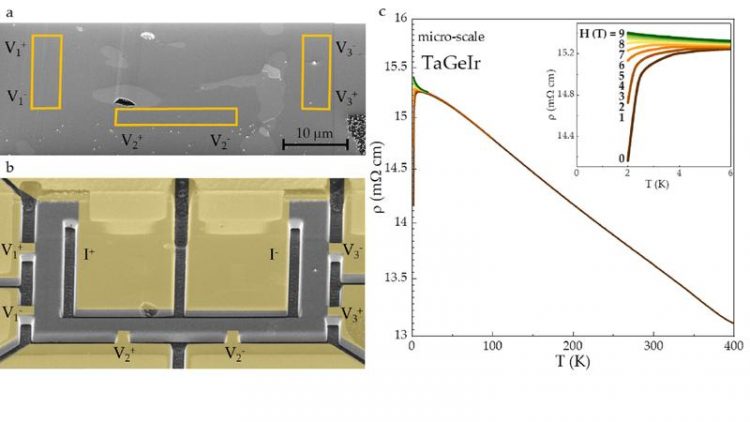An alternative route for studying the intrinsic properties of solid-state materials

Micro-scale device manufactured of polycrystalline TaGeIr MPI CPfS
To understand the origin of conflicting reports on TaGeIr, scientists from MPI CPfS and Northwestern University investigated the deviation of the crystal structure from the ideal MgAgAs model, possibility of off-stoichiometry (presence of homogeneity range), impact of the synthesis route on the real structure, as well as metallographic features of TaGeIr.
As a result of this comprehensive study, the presence of minority phases (resulting from the phase equilibria in the ternary system and not complete homogenization even by long thermal treatment) in TaGeIr specimens were found to result in extrinsic metallic behavior, as well as in appearance of superconductivity at low temperatures.
To study intrinsic properties of TaGeIr, the manufacturing of micro-scale devices was applied (Figure 1), and semiconducting behavior of TaGeIr was conclusively established.
The semiconducting properties of TaGeIr agree with electronic band structure calculations, revealing existence of the band gap only in case of MgAgAs-type structure with iridium atoms in heterocubic site (Figure 2). The latter is consistent with single crystal diffraction studies.
Figure 1. Micro-scale device manufactured of polycrystalline TaGeIr: (a) scanning electron microscopy of synthesized specimen with single-phase regions of TaGeIr (orange rectangles), (b) micro-scale device for resistivity measurement, and (c) resistivity data, revealing semiconducting nature of TaGeIr.
Figure 2. Electronic density of states of optimized TaGeIr models with Ir, Ge and Ta atoms on heterocubic 4c Wyckoff site with corresponding atomic arrangements.
The research at the Max Planck Institute for Chemical Physics of Solids (MPI CPfS) in Dresden aims to discover and understand new materials with unusual properties.
In close cooperation, chemists and physicists (including chemists working on synthesis, experimentalists and theoreticians) use the most modern tools and methods to examine how the chemical composition and arrangement of atoms, as well as external forces, affect the magnetic, electronic and chemical properties of the compounds.
New quantum materials, physical phenomena and materials for energy conversion are the result of this interdisciplinary collaboration.
The MPI CPfS ( www.cpfs.mpg.de ) is part of the Max Planck Society and was founded in 1995 in Dresden. It consists of around 280 employees, of which about 180 are scientists, including 70 doctoral students.
Yuri Grin, Irina Antonyshin, Eteri Svanidze
Iryna Antonyshyn, Frank R. Wagner, Matej Bobnar, Olga Sichevych, Ulrich Burkhardt, Marcus Schmidt, Markus König, Kenneth Poeppelmeier, Andrew Mackenzie, Eteri Svanidze, Yuri Grin,
Micro-scale device – an alternative route for studying the intrinsic properties of solid-state materials: case of semiconducting TaGeIr, Angew. Chem. Int. Ed., accepted, DOI: 10.1002/anie.202002693.
Media Contact
All latest news from the category: Life Sciences and Chemistry
Articles and reports from the Life Sciences and chemistry area deal with applied and basic research into modern biology, chemistry and human medicine.
Valuable information can be found on a range of life sciences fields including bacteriology, biochemistry, bionics, bioinformatics, biophysics, biotechnology, genetics, geobotany, human biology, marine biology, microbiology, molecular biology, cellular biology, zoology, bioinorganic chemistry, microchemistry and environmental chemistry.
Newest articles

“Nanostitches” enable lighter and tougher composite materials
In research that may lead to next-generation airplanes and spacecraft, MIT engineers used carbon nanotubes to prevent cracking in multilayered composites. To save on fuel and reduce aircraft emissions, engineers…

Trash to treasure
Researchers turn metal waste into catalyst for hydrogen. Scientists have found a way to transform metal waste into a highly efficient catalyst to make hydrogen from water, a discovery that…

Real-time detection of infectious disease viruses
… by searching for molecular fingerprinting. A research team consisting of Professor Kyoung-Duck Park and Taeyoung Moon and Huitae Joo, PhD candidates, from the Department of Physics at Pohang University…





















